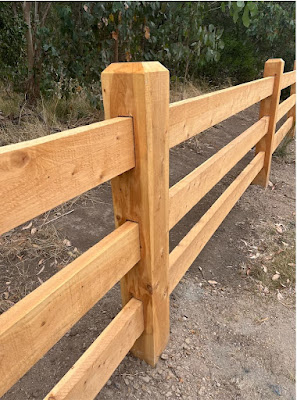A Practical Guide to Installing Ironbark Post and Rail Fencing
Tagged as: .
If you're considering enhancing your property with a rustic and durable fencing solution, look no further than Ironbark post and rail fencing. This classic style not only adds charm to your landscape but also serves as a robust boundary for your property.
In this guide, we'll take you through the step-by-step process of installing Ironbark post and rail fencing to ensure a successful and aesthetically pleasing outcome.
Understanding the Basics
Before diving into the installation process, let's familiarise ourselves with the key components of Ironbark post and rail fencing. This type of fencing typically consists of sturdy ironbark posts that support horizontal rails.
The natural durability of Ironbark makes it an ideal choice for outdoor structures, ensuring longevity and minimal maintenance.
Essential Tools and Materials
To get started, gather the necessary tools and materials for the project. You'll need:
- Ironbark posts
- Rails (also made of ironbark)
- Concrete mix
- Post hole digger
- Spirit level
- Nails or screws
- Saw
- Measuring tape
Ensuring you have all the required items will streamline the installation process and prevent unnecessary delays.

Step-by-Step Installation Guide
1. Planning and Layout
Begin by planning the layout of your fence. Mark the locations of the posts and rails, taking into consideration the terrain and any slopes. This step is crucial for achieving a balanced and visually appealing result.
2. Digging Post Holes
Use the post-hole digger to excavate holes for the ironbark posts. The depth of the holes should be sufficient to provide stability. As a general rule of thumb, aim for a depth of at least one-third the length of the post.
3. Setting the Posts
Place the ironbark posts in the dug holes and use a spirit level to ensure they are perfectly vertical. Once positioned correctly, fill the holes with concrete mix to secure the posts in place. Allow the concrete to set before proceeding to the next step.
4. Attaching Rails
Once the posts are firmly set, it's time to attach the ironbark rails. Measure and cut the rails to the desired length, ensuring they fit snugly between the posts. Secure the rails using nails or screws, maintaining an even spacing for a polished look.
5. Finishing Touches
Inspect the entire fence to ensure everything is securely in place. Trim any excess length from the posts or rails for a neat finish. Consider applying a protective sealant or paint to enhance the longevity of your Ironbark post and rail fencing.
Maintenance Tips
To keep your Ironbark post and rail fencing looking pristine, follow these maintenance tips:
- Regularly inspect for loose nails or screws and tighten as needed.
- Clear away debris such as leaves and dirt to prevent moisture buildup.
- Apply a fresh coat of sealant or paint every few years to protect against the elements.
By following these steps and incorporating routine maintenance, you'll enjoy the timeless beauty and durability of your post and rail fencing for years to come.
Installing Ironbark post and rail fencing is a rewarding project that adds both functionality and charm to your property. With the right tools, materials, and a careful approach, you can create a durable and visually appealing fence that stands the test of time.
Whether you're a seasoned DIY enthusiast or a first-time installer, this guide is designed to make the process accessible and enjoyable.
Source: https://thewoodprojectaus.blogspot.com/2024/01/a-practical-guide-to-installing.html